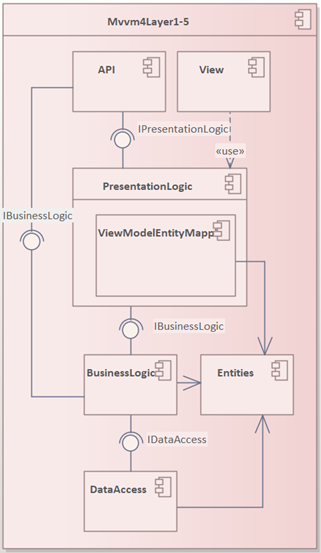This article shows different ways how to build the architecture at runtime. The architecture presented is a combination of layered architecture and the Model-View-ViewModel pattern. The evaluation was made to show the additional effort that arises without Dependency Injection (DI) (Mvvm4Layer1), with DI by factories (Mvvm4Layer2-4) and with DI container (Mvvm4Layer5).
Layered architecture is a quick and easy way to build a working software architecture. But note that there are better ways: Clean, Hexagonal, Onion Architecture etc. Better because the domain is in the centre.
- Mvvm: Model-View-ViewModel-Pattern
- 4Layer: Strictly speaking, there are 6 layers. However, the Entity component is seen here in parallel with PresentationLogic, BusinessLogic and DataAccess. In addition, the API is not considered a necessary part of the component. Accordingly, View, PresentationLogic, BusinessLogic and the DataAccess form the core architecture, which all depend on the entities.
No Dependency Injection for architecture structure! The class representing the layer n (e.g. BusinessLogic-Class) creates the class representing the layer n-1 (DataAccess-Class). BusinessLogic-Class creates DataAccess-Class This results in a direct dependency that can only be resolved to a limited extent. For example, we could create another constructor in which the required dependency can be initiated.
In this example the API of Mvvm4Layer1 Component must know something about the PresentationLogic- and BusinessLogic-Layer
Constructors are not independent testable (Unit Test):
- Mvvm4Layer1Factory -> you can not resolve dependencies to PresentationLogic-, BusinessLogic-, DataAccess- and Mvvm4Layer1-Class.
- PresentationLogic-Constructor instantiates: BusinessLogic-Class
- BusinessLogic-Constructor instantiates: DataAccess-Class
- DataAccess-Constructor -> you cannot resolve dependencies to the classes instantiating in the constructors
Rest of class could be made testable as follows: you would introduce a constructor only for the tests where the required dependency can be injected. Or use setter injection. I like to avoid the setter injection, because with it is very inconvenient to force an intra-packet set. The problem with internal setters is that they cannot be used in a public interface (in C#).
Dependency Injection (DI) for architecture structure with one Factory: Mvvm4Layer2Factory. Mvvm4Layer2Factory creates the PresentationLogic-, BusinessLogic- and DataAccess-Class.
In this example the API of Mvvm4Layer2 Component must know something about the PresentationLogic-, BusinessLogic- and DataAccess-Layer.
Mvvm4Layer2Factory is not independent testable (Unit Test):
- Mvvm4Layer2Factory -> you can not resolve dependencies to PresentationLogic-, BusinessLogic-, DataAccess- and Mvvm4Layer1-Class.
Testable (Unit Test):
- But you can test the constructors of PresentationLogic-, BusinessLogic-, DataAccess and Mvvm4Layer2-Class independent of other classes due to dependency injection.
Dependency Injection (DI) for architecture structure with factories
Mvvm4Layer3Factory creates the PresentationLogicFactory. Witch creates the PresentationLogic-Class for the Mvvm4Layer3-Class.
The API-Factory in the layer n (e.g. BusinessLogicFactory) creates the class representing the layer n and the API-Factory for layer n-1.
- BusinessLogicFactory creates BusinessLogic-Class and DataAccessFactory
- This can resolve the dependencies between the layer representing classes.
- But the dependencies are now in the Factory-Classes. -> e.g. PresentationLogicFactory depends on BusinessLogicFactory
In this approach each layer n only knows something about layer n-1. -Exception: API-Subcomponent must know something about PresentationLogic- and BusinessLogic-Layer.
- The layer representing classes are independent testable.
- The factories of each layer are harder to test because we can not resolve the dependencies to the created classes.
Dependency Injection (DI) for architecture structure realized by factories.
The Mvvm4Layer4Factory-Class creates PresentationLogic-, BusinessLogic- and DataAccess-Factory.
The PresentationLogic-, BusinessLogic- and DataAccess-Factory than create the PresentationLogic, BusinessLogic and DataAccess Class.
-> In this example the API of Mvvm4Layer4 Component must know something about the PresentationLogic-, BusinessLogic- and DataAccess-Layer.
- The layer representing classes are independent testable.
- The factories of each layer are harder to test because we can not resolve the dependencies to the created classes.
- In this approach the Mvvm4Layer4Factory-Method witch creates the PresentationLogic-, BusinessLogic-, and DataAcces-Factory is also testable because of the interfaces of each factory and Constructor-Injection.
Dependency Injection (DI) for architecture structure with DI-Container (Ninject)
Mvvm4Layer5-Component needs to initialise Kernel-Bindings. This happens in Mvvm3Layer5Modulue-Class in the DependencyInjectionContainer-Folder
The client how want to use the Mvvm4Layer5-Class must use the Kernel (Ninject Container) to get it. The Kernel resolve all needed dependencies.
- In this approach API-SubComponent must know something about PresentationLogic- and BusinessLogic-Layer.
- The BusinessLogic layer must be known because the API must access business functionality directly.
Beware: Maybe it could be possible that someone who uses the same Ninject Kernel (Container) than our Component (Mvvm4Layer5) can use a Class we don't want anyone else to use. BUT: this should not be possible when we set this Classes internal. Constructors of this classes must be public because Ninject needs them public. But we can set the types internal.
The layer representing classes PresentationLogic-, BusinessLogic-, and DataAccess-Class can be tested independent.





